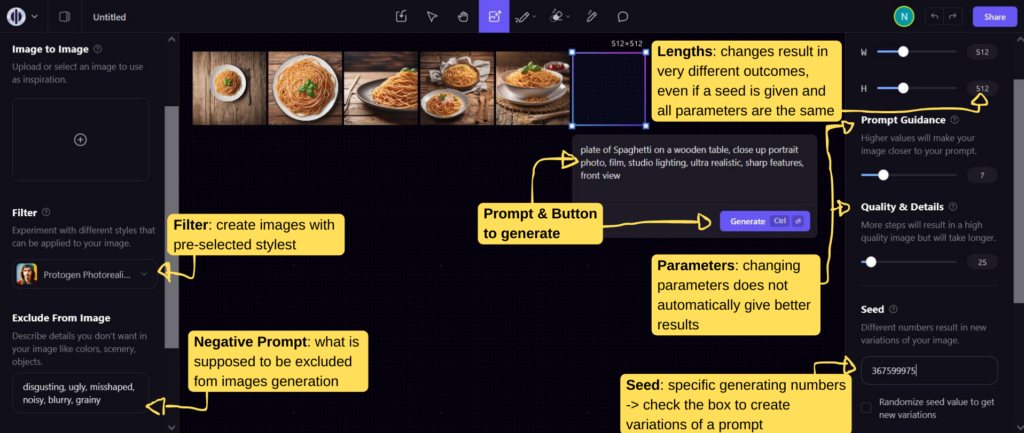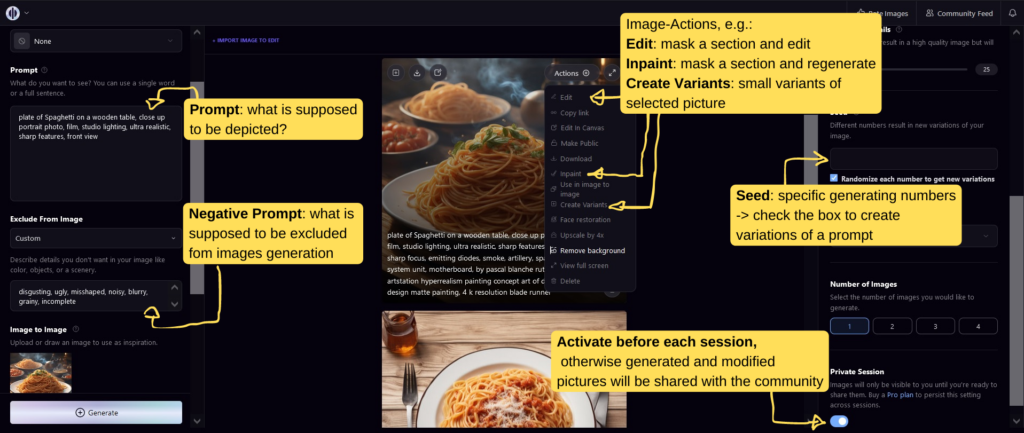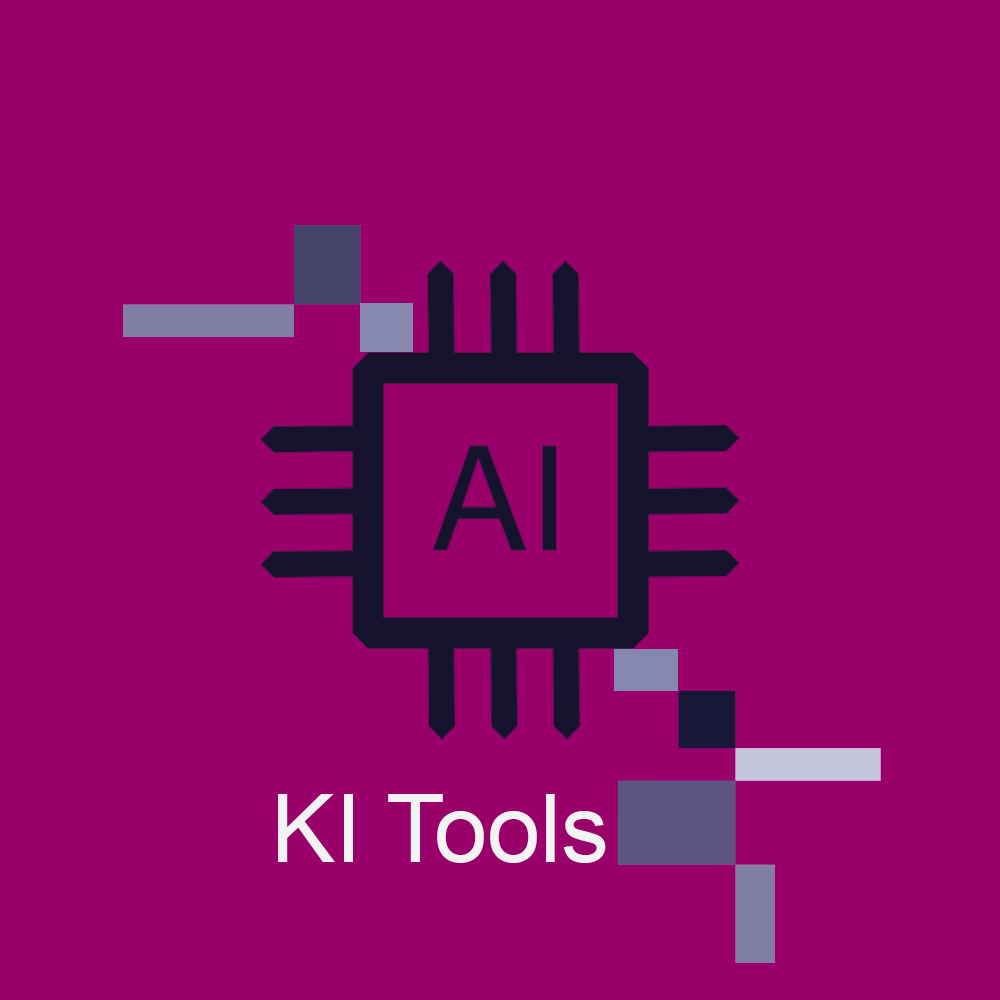With the "Deus Ex Machina? — Testing AI Tools"-series we want to show you different tools, that aim to simplify writing, design and research by using Artificial Intelligence. More on the "Deus Ex Machina?"-series can be found here.
A contribution by Helena Bodem (study program Science-Media-Communication, KIT Karlsruhe)
Overview
The digital tool Playground AI (playgroundai.com) is an image generator that provides an easy way for both non-experts and experienced users to create and edit images. At the heart of the tool is a "text to image" AI that allows users to generate images or modify existing images using specific text instructions (prompts). Because a "text to image" generation leaves a lot of room for random results, another text input is possible below the prompt field: the so-called "negative prompts", which can be used to explicitly exclude certain features or elements from the image generation.
A range of possible filters and controls can be used to fine-tune the image generation. However, since the underlying effects are not intuitively accessible, it is advisable, especially for non-professionals, to stay within the standard settings for the time being. Especially at the beginning, users may be overwhelmed by the variety of results: even if you simply leave the same text prompt and click on "Generate" several times, the tool produces different image interpretations. Users can also upload their own photos and modify them with the AI. Both an existing and a generated image can be edited by masking parts of the image and changing masked objects or adding new objects via "Edit Instruction".

Negative Prompt: disgusting, ugly, misshaped, noisy, blurry, grainy, incomplete

Anyone who wants to use the tool needs a Google account. In the free basic version, up to 1000 images per day can be generated or edited. The images generated in this way can not only be downloaded, but also scaled up in quality. While Playground AI allows users to use the images for private and commercial purposes, copyright and ethical issues remain with this image generator as well.
The AI behind the application
The technology that powers Playground AI is based on various versions of the Stable Diffusion AI model. Its name is derived from the company name Stability AI, which was instrumental in the development of Stable Diffusion. Stability AI invested significant amounts of GPU computing power to enable the training of this model. Although there are various "text to image" AI models, with Dall‑E probably being the most prominent, Stable Diffusion stands out in that it is the only one of its kind to have been published in open source format: The model is completely open to public scrutiny and can be modified by the developer community.
In its mode of operation, Stable Diffusion uses the principle of diffusion, whereby images are modified by repeatedly adding Gaussian noise, i.e., the pixels of an image are blurred until it consists only of different coloured spots or dots. The AI model is then trained to reconstruct the "noisy" image, creating a variation of the original image.
In order for "text to image" AIs to generate the most diverse images possible, a large set of training data is needed. In the case of Stable Diffusion, a data set known as LAION 5B was used. It contains an impressive 5.8 billion HTML links to corresponding image-text pairs. However, in creating this set, little consideration was given to content rating, copyright or privacy of the images. For example, one artist discovered medical images in the set that had been taken of her before and after an operation. The artist now has little chance of having these images deleted. According to LAION's terms and conditions, owners of images can only request the deletion of links from the set if identifiable data can be found on the linked images, e.g., name, telephone number or address.
(Further information on ethical and legal conflicts can be found in the section "Usage in science communication" and in the info box).
The rhetorical potential of the tool
People with creative and design backgrounds are likely to be particularly attracted to Playground AI. However, the tool's ability to quickly visualize ideas and make adjustments to images without prior knowledge of professional editing programs also makes it interesting for a broader audience.
However, it should be emphasised that Playground AI is not completely intuitive to use. Formulating an effective text prompt requires practice. For effective prompting, it is advisable to use "tags", short image descriptions that usually consist of one or two words and are strung together separated by semicolons. There are also a variety of filters, adjustment parameters and editing options to help refine the results. This can be overwhelming for beginners at first.
A characteristic feature of "text to image" models is a high random factor when generating images. This is particularly evident when using Playground AI: users can press the "Generate" button repeatedly without changing the settings or prompt, and still get different results each time. In fact, the results are so varied that one quickly wants to move on to varying a particularly interesting image. Creating variations of a particular image is possible, for example, via the generation number of an image, the so-called seed. (In the user interface "Board" there is even a selectable action for this).
Another annoyance is that the tool seems to have difficulties with the generation of special details such as fingers and toes. However, to fix this and similar issues, Playground AI provides some lengthy YouTube tutorials.
The tool has two user interfaces — Board and Canvas — which are quite similar in functionality but have different emphases for use. While Canvas is particularly suitable for generating images in quick succession, Board is optimal for creating variations of an already created image.


An important note about the board: here, images are automatically shared with the community unless the share function is disabled before generation. This setting must be re-set before each use.
Usage in science communication
During a self-test the possibilities and limitations of the tool became evident. Playground AI proved useful for designing a cover image for a journalistic article on artificial intelligence. A simple prompt like "Artificial Intelligence" combined with various filters and settings quickly delivers innovative image concepts. With adjusted prompt input and correct image ratio, an appealing result can be achieved.

Prompt: Artificial Intelligence, Intelligence, interesting, connections, illustration, article
Negative Prompt: human, human face, disturbing, noise, too much detail
In contrast, the attempt to create a simple diagram with four labels failed. Although there are probably ways to give the tool more precise instructions, the high randomization factor in image generation by Playground AI still stands in the way of creating accurate diagrams. And what about scientific representations? For example, is it possible to generate a microscopic view of the bird flu virus? Even though the virus has already been extensively researched, the project proved difficult without a concrete image template.

Prompt: bird flu virus, Avian influenza, virus, structure, science, microscope, scientific, microscopic
Of course, science communication does not only take place via articles and scientific papers. Social media platforms are also important distribution tools. Here, colorful images are often needed to attract the attention of users. Especially for this purpose, the tool quickly delivers promising results.

Prompt: science, communication
Negative Prompt: bad illustration, disproportioned, kitsch, morbid
Good to know: Since the AI model Stable Diffusion was trained with images of 512 x 512, Playground AI generates particularly good images in this aspect ratio. For image series, it is therefore advisable to leave the preset height and length at 512 and to subsequently upscale selected images (right-click > "Upscale by 4x").
If you are now holding your self-generated images in your hands, you are probably asking yourself questions about image rights and use. In the FAQs (as of 04.09.2023), Playground AI gives a generous answer to the question "How does copyright work? Do I own the images I create?": All rights, titles and interests in the images created are left to the users — both for private and commercial purposes.
However, the matter is presented in a more differentiated way in the terms of use. Here, Playground AI, as well as its legal successors and agents, reserves far-reaching rights of use. This extends not only to content generated with the tool, but also to any images contributed by users. Furthermore, those who fail to create their images in a private mode (which must be done again at the beginning of each board session) also grant other members of the platform a non-exclusive licence to use them.
The case of DeviantArt case: Ethical conflicts with AI-generated art
DeviantArt, a popular platform among art creators, came into the spotlight when it introduced a "text to image" tool called "DreamUp". The problem was that DeviantArt automatically marked all the artworks of its users as usable for AI records. In addition, some of the AI-generated images had striking similarities to existing artworks. A group of art creators joined together in a class action lawsuit for copyright infringement, and the DeviantArt case sparked a heated debate about the ethical limits of AI in the art field: can technology really be creative if it merely modifies the intellectual property of others?
What this means in concrete terms: Anyone who feeds their own image into the tool, e.g. as a template or for editing, should always be sure that they own the corresponding rights to it. Because you have to reckon with the fact that Playground AI will continue to use this image. In addition, Playground AI makes it clear in its terms of use that users themselves are responsible for their activities and points out that generated images may unintentionally resemble protected images. So in practice, it is probably advisable to at least do a Google Image search before using a generated image for publication purposes.
It should also be borne in mind that, as things stand, it is still very uncertain whether copyright or copyrights can be claimed for AI-generated images. In the US, courts have already rejected copyright claims. So while commercial use is unlikely to be a problem, it may be difficult to take legal action if another person uses one's AI-generated work.
Wrap-Up
"Playground AI" delivers what its name promises: it offers a creative playground where users can try their hand at words and settings to their heart's content to quickly get visually appealing results. But the initial euphoria can quickly turn into frustration if the desired result seems unattainable. Particularly in the context of science communication, where accuracy and precision are paramount, Playground AI has its limitations and is more suitable for creating decorative accessories.
Further research on the tool evokes mixed feelings: On the one hand, it is motivating to push Playground AI to get even better results through improved prompts and more precise settings. On the other hand, one quickly comes across information that images were used for the tool's AI whose creators neither agreed to nor were paid for them to be used.





